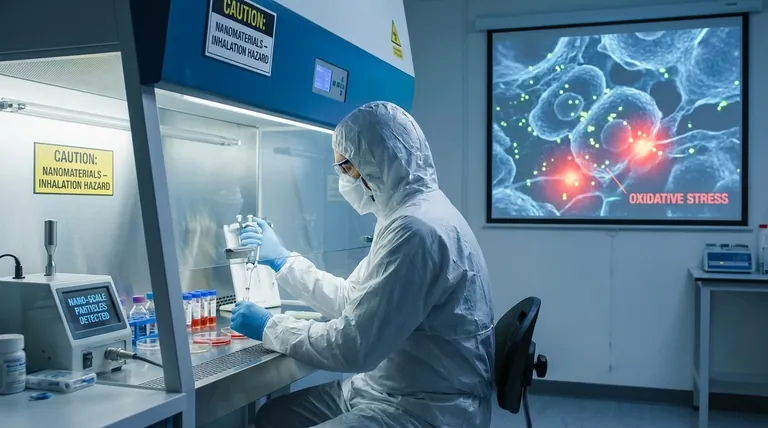In short, the primary hazards of nanoparticles stem from their incredibly small size, which grants them properties not seen in their larger, bulk-material counterparts. This size allows them to easily penetrate the body's natural defenses, leading to cellular damage through mechanisms like oxidative stress and inflammation. The specific danger varies significantly based on the nanoparticle's composition, size, shape, and surface characteristics.
The fundamental hazard of nanoparticles is not merely their chemical makeup, but how their microscopic scale fundamentally alters their interaction with biological systems. This new class of interaction allows them to bypass cellular defenses and trigger damaging processes that larger particles of the same material simply cannot.

Why Size is the Critical Factor
The transition from a bulk material to a nanoscale particle creates entirely new toxicological concerns. A block of inert gold is safe, but gold nanoparticles can exhibit unexpected biological activity.
Penetrating Biological Barriers
Because they are often smaller than cellular components, nanoparticles can bypass the protective barriers that effectively block larger particles. This includes the ability to be inhaled deep into the lungs, potentially cross into the bloodstream, and in some cases, even penetrate the blood-brain barrier or cross the placenta.
The Surface Area to Volume Ratio Problem
As a particle's size decreases, its surface area relative to its volume increases exponentially. This dramatically larger surface area means more of the material's atoms are exposed and available to react with surrounding tissues. This heightened reactivity is a primary driver of toxicity.
Quantum Effects and Increased Reactivity
At the nanoscale, quantum effects can begin to influence a material's properties. This can alter the particle's electronic structure, making it a more potent catalyst for producing reactive oxygen species (ROS), also known as free radicals, when inside the body.
The Primary Mechanisms of Nanotoxicity
Once inside the body, nanoparticles can cause harm through several well-documented biological pathways. These mechanisms are often interconnected.
Oxidative Stress: The Core Threat
This is the most common mechanism of nanoparticle-induced injury. The high reactivity of nanoparticles can lead to the overproduction of ROS within cells. This creates an imbalance known as oxidative stress, which can damage proteins, lipids, and DNA, ultimately leading to cell death.
Inflammatory Response
The body's immune system often recognizes nanoparticles as foreign invaders, triggering an inflammatory response. While acute inflammation is a normal healing process, chronic inflammation caused by persistent nanoparticle exposure can lead to tissue damage and is linked to long-term diseases.
Genotoxicity and DNA Damage
Some nanoparticles have been shown to cause damage to cellular DNA. This can happen directly, through physical interaction with the DNA strand, or indirectly, through the byproducts of oxidative stress. Such genotoxicity can lead to mutations and increase the long-term risk of cancer.
Fibrosis: The Asbestos Analogy
Certain types of nanoparticles, particularly high aspect-ratio materials like carbon nanotubes, can trigger a response similar to that of asbestos fibers. If they cannot be cleared by immune cells, they can cause chronic inflammation and the formation of scar tissue (fibrosis), especially in the lungs, impairing organ function.
The Critical Distinction: Hazard vs. Risk
It is crucial to differentiate between the intrinsic properties of a nanoparticle and the actual danger it poses in a real-world scenario.
Hazard Is Not Risk
A hazard is the intrinsic capacity of a substance to cause harm (e.g., titanium dioxide nanoparticles can generate ROS under UV light). Risk is the probability that this harm will occur, which depends on both the hazard and the level of exposure. A highly hazardous material may pose a low risk if it is perfectly contained.
Identifying Exposure Routes
The risk is heavily dependent on how a person might be exposed. The primary routes are:
- Inhalation: The most significant route for occupational exposure, leading directly to the lungs.
- Dermal Contact: Intact skin is a relatively strong barrier, but some smaller nanoparticles may penetrate, especially through damaged skin.
- Ingestion: Exposure through food, water, or hand-to-mouth contact is possible, particularly with consumer products.
The Challenge of Detection and Measurement
A significant practical problem is that nanoparticles are difficult to detect and measure in the environment or workplace. Standard dust monitoring equipment is often inadequate, making it challenging to accurately assess exposure levels and enforce safety limits.
Applying This Knowledge to Your Work
Understanding the specific mechanisms of nanotoxicity is the first step toward effective risk management. Your approach should be tailored to your specific role and objectives.
- If your primary focus is research and development: Prioritize "Safety by Design" by selecting particle sizes, shapes, and coatings known to have lower biological reactivity.
- If your primary focus is occupational health and safety: Implement a hierarchical control approach, focusing first on engineering controls (e.g., ventilation, containment) to minimize inhalation exposure.
- If your primary focus is regulation or product stewardship: Advocate for material-specific risk assessments, as the hazards are too diverse for a "one-size-fits-all" approach to safety.
By understanding these specific hazards, we can implement informed strategies to manage risk and safely unlock the immense potential of nanotechnology.
Summary Table:
| Hazard Mechanism | Key Consequence |
|---|---|
| Deep Biological Penetration | Bypasses lung, blood-brain, and placental barriers. |
| High Surface Area Reactivity | Drives oxidative stress and cellular damage. |
| Inflammatory Response | Triggers chronic inflammation and tissue damage. |
| Genotoxicity | Can cause DNA damage, increasing cancer risk. |
| Fibrosis (e.g., from nanotubes) | Leads to scar tissue formation in organs like lungs. |
Safeguard your laboratory and research with KINTEK.
Effectively managing nanoparticle hazards requires the right equipment and consumables. KINTEK specializes in high-quality lab equipment designed for safe handling, containment, and analysis of nanomaterials, helping you mitigate risks like inhalation exposure and cross-contamination.
Let our expertise support your safety protocols. Contact our team today to discuss your specific needs and discover how our solutions can enhance your lab's safety and efficiency.
Visual Guide

Related Products
- Super Negative Oxygen Ion Generator Machine for Air Purification
- Nickel Foam for Industrial and Laboratory Applications
- HFCVD Machine System Equipment for Drawing Die Nano-Diamond Coating
People Also Ask
- What are environmental impacts of biomass? Balancing Sustainability with Potential Harm
- What are the safety concerns of biomass energy? Health and Environmental Risks Explained
- What is the vacuum sublimation method? A Guide to High-Purity Material Purification
- What is the difference between oxidizing and reducing environments? Key Insights for Chemical Reactions
- What is a disadvantage of biomass energy? The Hidden Environmental and Economic Costs


